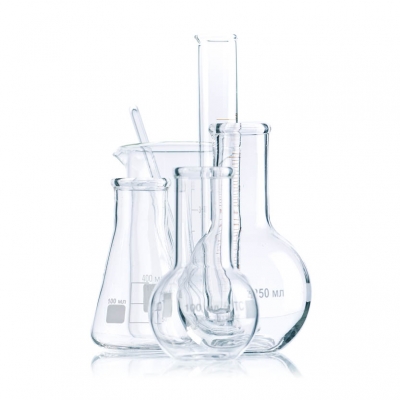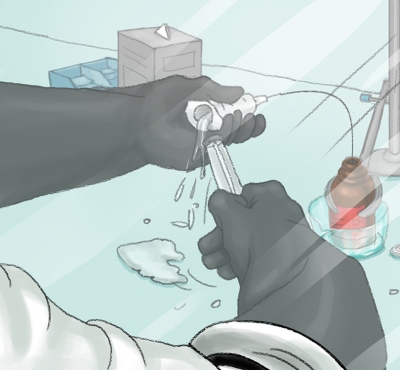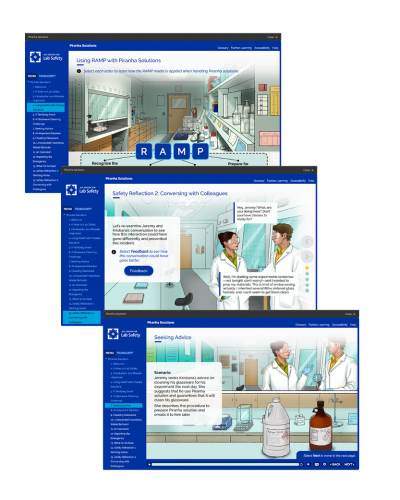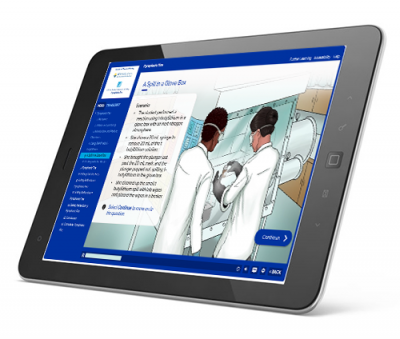ACS Case Studies for Research Lab Safety
Help your students learn advanced safety skills through real-world case studies
ACS Case Studies for Research Lab Safety takes a case study approach to teaching and learning with a library of self-paced case studies, through which students learn fundamental risk assessment skills that are universally applicable to all research laboratories.

Why ACS Case Studies for Research Lab Safety
ACS Case Studies for Research Lab Safety is a 90-minute course that guides students and faculty through five real-world lab safety incident case studies. Based on the RAMP model, this course teaches fundamental risk assessment skills that are universally applicable to all research environments throughout their academic career and into the industry.
Each case study leads students through the exploration of a real-world research laboratory incident with questions that prompt them to reflect on how and why incidents happen. This process helps students reason through decisions at various levels and identify ways to assess risks and minimize hazards, even when performing common tasks in the lab.
Course Demonstration
Watch a short video that demonstrates one of the case studies featured in this course, Piranha Solutions.
Get Evaluator Trial
Vivid Illustrations
Vivid illustrations and simulated conversations make each scenario relatable and increase students’ awareness and readiness before they receive more thorough safety lectures.
This interactive and modular course, together with supplementary materials all in one place, makes it easy for instructors, principal investigators, and EHS or lab managers alike to put the RAMP model into action in their department or institution. These case studies also help stimulate important conversations around risk assessment and research safety.
When adopted in conjunction with other ACS safety courses, ACS Case Studies for Research Lab Safety helps cultivate a safer learning environment for all who work and study on their campus.

Features
- A readily available tool that reduces the burden of curriculum development and completion management on faculty and staff
- Easy integration into the upper-division undergraduate and graduate curriculum
- Authoritative best practices designed and created by lab safety experts
- Equip students with risk-based thinking skills and good safety habits that last throughout their academic career and into the workplace
- An immersive storytelling experience, making the case study relatable and memorable
- Increase the confidence of everyone who studies and works in and around labs
- Prioritize lab safety as a core competency for all researchers
- Enhance the safety culture in your institution
Trusted Subject Matter Experts
We have a team of experienced researchers and educators who are committed to delivering up-to-date, high-quality content. Each case study is carefully chosen to illustrate the crucial safety skills every student researcher needs.
University of North Carolina at Chapel Hill
David Lawrence is the Fred Eshelman Distinguished Professor and a faculty member in Chemistry, Pharmacy, and Pharmacology. His research interests include light activated drug delivery, optogenetics, chemical cytometry, and technology integration in laboratory safety.
Northwestern University
Michael Blayney is the Executive Director of Research Safety at Northwestern University. Throughout his career, Michael has developed laboratory safety training curricula.
Ultrafast Optical Engineer
Edmund Optics
Dr. Williams began her career in laboratory safety while obtaining her Ph.D. at the University of North Carolina at Chapel Hill, where she served as the founder of the graduate student safety committee. She brings her expertise in laser safety and experience in graduate-level safety education to this course.
Wittenberg University (retired)
An ACS CHAS Fellow who was awarded the Howard Fawcett Chemical Health and Safety Award in 2020, Dr. Finster has served on the ACS Committee on Chemical Safety and the Division of Chemical Education Safety Committee. He is a co-author of the textbook, Laboratory Safety for Chemistry Students and co-author/editor of the 8th edition of the ACS publication Safety in Academic Chemistry Laboratories. He was the Chemistry Hygiene Officer at Wittenberg for 20 years and a volunteer firefighter for 24 years.
Course Outline
• Basics of risks assessment and minimization
• Applications of the RAMP model in research labs
• Choose the appropriate fire extinguishers
• Apply RAMP when working with pyrophoric chemicals
• Identify key hazards of pyrophoric reagents
• Minimize the risks of these key hazards
• Properly clean up a spill in the glove box and handle the waste
• Respond effectively to an emergency involving pyrophoric reagents
• Best practices to prepare for emergencies
• Supplies and equipment needed to minimize risks
• Apply RAMP when working with piranha solutions
• Identify hazards and risks of working alone in the lab
• Glassware cleaning and hazardous waste behaviors
• Minimize risks when performing routine housekeeping
• Respond appropriately during an emergency involving injuries
• Using RAMP when scaling up a reaction
• Preparing glassware
• Pyrophoric scale-up
• Recognize hazards associated with complex situations
• Describe the correct way to use a centrifuge
• Analyze how to respond effectively to a situation involving multiple experimental errors
• Recognize hazards in moving or organizing chemicals in storage
• A sulfuric acid spill
• Identify ways to minimize risk when handling hazardous chemicals
• Prepare for emergencies involving hazardous chemicals
• Using RAMP when transporting chemicals
• Minimize spill risk during transport of hazardous chemicals
• Respond appropriately to a hazardous spill in a public space
• Get help and contact EHS

Illustrations based on real-world lab incidents
Each case study, presented with illustrations and simulated conversations, leads the learner through the exploration of a real-world research laboratory incident and helps them identify risks and recognize hazards around the common tasks and chemical reagents in every research lab.
Request a DemoGet Access
ACS Case Studies for Research Lab Safety is available to academic, corporate, and government institutions. This course can be easily integrated into your existing learning management system (LMS). Pricing is tiered based on the number of learners.
Access is available for course evaluation and review. Click below to get started, and we'll be glad to help set up a course demo, evaluation, and quotation.
Get Started
Explore Other Lab Safety Solutions in the Series
System Requirements
In order to use this course in the academic environment, it must be integrated into a learning management system (LMS). Our digital learning solutions are compatible with most commonly used systems such as those specified here. If you don’t see your LMS or the file format that your LMS requires, let your ACS representative know and we will work with you to test your learning environment.
ACS Institute courses are provided in standard eLearning package formats for import into customer Learning Management Systems. The following package format options are available:
• SCORM 1.2
• SCORM 2004 3rd Edition
• AICC
• LTI 1.1
• LTI 1.3v
Verified Learning Management System-Package Format Combinations
The following combinations have been tested and verified:
• Moodle / SCORM 1.2
• Canvas / LTI 1.1
• Canvas / LTI 1.3
• Blackboard / SCORM 1.2
• Docebo / SCORM 1.2, SCORM 2004 3rd Edition, LTI 1.1






